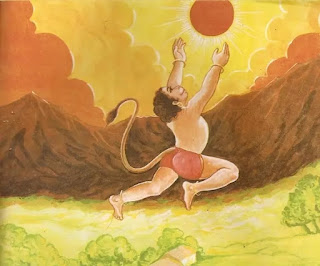Reading Notes: Sita Sings the Blues Part B
Reading Notes: Sita Sings the Blues Part B
Sita Sings the Blues --- by Nina Paley (Question Copyright)
So, I actually ended up watching all of the film last night because it was so enthralling that I couldn't put it down. I got notes on the main plot points last night, but I wanted to jot down some more thoughts about storytelling devices and just give general impressions about the film now that I've had some time to let the content sink in.
I absolutely loved this film. My biggest critique of the Ramayana was how unsatisfying the ending was. I felt this way solely because of how the relationship between Rama and Sita died at the end. While it would be disingenuous and would actually damage the story (in my opinion, I'll get to that in a bit) to have their relationship be magically repaired at the end, it was refreshing to consider things from Sita's point of view. Realistically, it shifted the protagonist from Rama (as it would be in a more traditional rendering of the Ramayana) to Sita. This was really a smart move because it allows the interpreter to present Sita as her own character.
I think the reason that Rama and Sita pair well together is that they complement each other as characters. In my opinion, Rama is a dynamic character. We see him throughout the Parts A, B, and C of the Ramayana as this bad*ss, demon-slaying rockstar who is sent to Earth to destroy Ravana. However, in Part D, we see this reconciliation of worlds. Rama now has to reconcile the needs of the divine world with the needs of the mortal world. This actually plays into his tragic flaw: he is seen as the embodiment of perfection. Being the embodiment of perfection has its benefits as a deity (or Avatar of a deity, to be precise), especially in combat when you get to wield a weapon of Brahma and simply destroy everything that opposes you. However, on the mortal side of things, perfection has a cost. As any artist would know, perfection is never truly attainable. It is something that we can strive for, but we will never truly be able to be perfect. But that's not the extent of the problem. It's an extremely slippery slope from chasing perfection to causing self-destruction. Rama destroys himself because he has a need to maintain this image of perfection. When his subjects start to ridicule him for taking back his wife (including the man in the Ayodha village who tells his wife "who do I look like [to take you back after you were unfaithful], Rama?" Rama is painfully aware of his reputation as perceived by his subjects. Not only is he aware of this, but his need for external validation causes him to weigh these comments and opinions heavily. This ends up driving a wedge between him and Sita and eventually causes them to go separate ways.
Conversely, (in my opinion) Sita is a static character. She wants to be with Rama throughout the story, pretty much from when they meet. She wants to be loved by Rama and she wants to see him uplifted. It's worth mentioning that she goes to pretty great lengths to amplify Rama and his abilities. The narrators in Sita Sings the Blues discuss this, and I mentioned it in my notes from yesterday: there's a significant plot point as Hanuman is flying away from a burning Lanka. Why did Sita not go with him? It's been established at this point that Hanuman can change size at will and he could have easily leapt over with Sita in his arms or on his back. This action would have prevented an all-out siege on Lanka and would have saved thousands of ape soldier lives (and rakshasas, too). So, why didn't she go with Hanuman? Sita possesses a need for internal validation. She needs Rama to be her rescuer, so that he can perform his selfless and heroic deeds and she can be the apple of his eye. Similarly to Rama, this plays right into her tragic flaw: her unwavering loyalty. After Rama and the people subsequently demand test after test to prove Sita's chasteness, it gets to a point where it seems the final test is nothing short of reclamation into the earth itself. If she wasn't so loyal to and obsessed with Rama, she could have jumped ship much earlier, so to speak.
These notes ran a little long, but I thought a lot about the plot and the characters of the Ramayana over the past 24 hours, and seeing this through Sita's POV actually helped me reach a lot of these conclusions. We were able to see her character development and shine a light on her motivations. I would like to quickly amend a comment I made on my reading yesterday. I noted that it seemed a little odd that the story seemed to start in media res and didn't even cover the parts about Rama leading up to his meeting Sita. I realized later on last night why that is. It's pretty obvious in hindsight: in this rendition, Sita is framed as the main character, so why would there be framing on Rama and then a frame shift to Sita when she first enters?
---------------------------------------------------------------------------------------------------------------------
(Rama (cartoon) - image credit)




Comments
Post a Comment